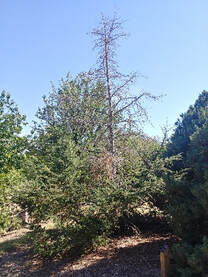
Stress is cumulative. In other words, trees and shrubs can be affected by stresses that happened up to several years in the past. The primary cause of this year’s tree damage was likely the sharp drop in temperature during last fall. The extreme cold last February didn’t help anything but may not have been the major driver for the damage we are seeing this year.
Let’s look at last fall in more detail. The Wichita area went from a daytime high of 87 on October 22, 2020 to a low of 24 degrees on October 26. Unfortunately, trees were not hardened off before this happened. In other words, they were not ready for these cold temperatures. Trees that are marginally cold hardy such as Atlas Cedars are most likely to be affected.
A sharp drop in temperature may damage at least a portion of the phloem and the cambium. Remember the phloem carries food made in the leaves to all parts of the plants including the roots. The cambium produces new phloem and xylem. If the phloem and cambium are killed, the cambium cannot produce new, living phloem, and, therefore, the roots don’t receive the food needed to survive as food produced in the leaves cannot be transported to the roots. What about the xylem that carries water and nutrients from the roots throughout the plant? Why is the xylem still able to function when both the phloem and cambium have been killed?
The reason the tree can still distribute water to the top portion of the tree is due to how a tree grows and, specifically, how xylem works. Even in perfectly healthy trees, most of the xylem is dead. Portions of this dead xylem forms hollow tubes that carry the vast majority of water and nutrients throughout the plant. Though there are living xylem cells, the contents of those cells make them inefficient in moving water. Therefore, the functional portion of the xylem wasn’t hurt by the freeze because it was already dead. Since this xylem system still works and provides water for the tree, the tree can live for quite a period of time.
Trees so affected will not die immediately. First of all, a healthy root system has stored energy reserves that it can use to keep the tree alive. When those reserves are depleted, the entire tree or a portion of the tree will die very quickly. Usually this occurs during the summer following the year the damage occurred. That is what we saw this summer with the Atlas Cedars.
So, is there anything we can do now to help the trees? Those that collapsed are done for. Those that suffered lesser damage should evaluated as to whether they would be worth keeping once the dead is pruned out. Those that are should be watered to prevent further stress. Keep the soil moist but not waterlogged (Ward Upham)
 RSS Feed
RSS Feed
